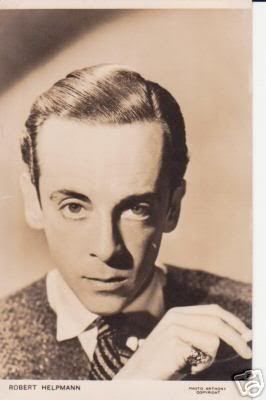Robert Helpmann haunted my childhood. Forget Darth Vader, the Child Catcher in Chitty Chitty Bang Bang was much more frightening. Darth Vader frightened me in a dark cinema, the Child Catcher in a well-lit family room and followed into my dreams at night.
Helpmann is a major figure in the history of English and Australian ballet, as well as an actor, playing lead roles with the Old Vic and touring Australia and the United States, directed ballet, plays and opera, as well as choreographer and creator of ballets. Indeed, I see the Australian Ballet is doing The Merry Widow, which was created by Helpmann and was a major critical and popular success around the world. He appeared in Olivier’s Henry V and Powell and Pressburger’s The Red Shoes (for which he also choreographed the ballet in the film.) He was created a knight and a major Australian performance award is named after him.
And yet I wonder if he isn’t a somewhat forgotten figure. Maybe I’m projecting my own ignorance onto the wider public (and my ignorance of ballet is almost profound in its totality) but I think Nellie Melba or certainly Joan Sutherland would have greater name recognition. Graham Murphy, who started as a choreographer under Helpmann, would possibly be our most recognised male ballet dancer and choreographer. And yet in terms of the depth and width of impact over a wide range of artistic endeavours, Helpmann leaves them all in the shade. No shame on them, but shame on us if Helpmann is not the well-remembered artist he should be.
This was all prompted by Anna Bemrose’s 2008 book Robert Helpmann: A servant of art. I’m afraid I’m going to have to call this a worthy book. The writing is dry and uninvolving. Though it covers Helpmann’s career and major works in good detail, Helpmann’s personality comes through only fitfully in glimpses. There is little or no mention of his private life which is fine but I don’t feel I know Helpmann, or indeed his inspirations and drive, any better for having read this book, and I wish I did. Perhaps a book of other people’s recollections of Helpmann might serve better in this respect, such as George Plimpton’s book on Truman Capote. It is only in the quotations from people such as Maina Geilgud and Margot Fonteyn that we see the man. Which was a little disappointing.
However, it is a sobering thought to realise on reading books such as this and John Bell’s autobiography just how young the professional performing arts companies in Australia are. I have had the privilege and pleasure of working with people who were part of the creation of the Queensland Theatre Company as well as other companies. Opera Australia was only created in the 1950s, Australian Ballet 1960s, the acting companies in the 70s. If we still have the challenge of finding audience and justifying ourselves to governments, funding bodies and the general audience, surely part of the reason is the profession’s relative youth. If we are not part of the lifeblood of Australia in the same way sport is, we’ve been doing sport a lot longer. Maybe we will never make that grade, and will always be a niche market. Certainly theatre in all its forms is struggling all over the world. Stephen Sondheim in his book Finishing the Hat says he now wonders, as he once never did, if there will always be a place for live theatre. Australia has come to the game late, and maybe we are fighting the darkness, but sunsets can dazzle. For some people, it’s the best part of the day.


Wonderful. Do you have Finishing the Hat?
ReplyDelete